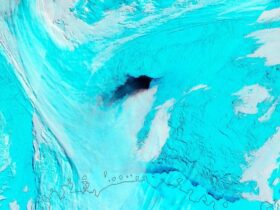New 2025 research suggests Earth’s past—and future—may look a lot greener from space than we thought
We’re used to calling Earth the “pale blue dot.” But new research published in Nature (April 2025) by a Japanese-led team reveals that our oceans may have once glowed green, thanks to a strange mix of ancient microbes, iron chemistry, and early photosynthesis.
That’s not just an aesthetic footnote in Earth’s history. It might be a clue to where life begins—and how it could end.
Let’s unpack what this actually means (without falling into a sci-fi spiral), and why you might want to pay more attention to the color of water.
What Turned the Oceans Green?
Roughly 3.8 to 1.8 billion years ago, during the Archean and Paleoproterozoic eons, Earth’s oceans were chemically alien by today’s standards—loaded with dissolved iron and zero oxygen. Life was microscopic, confined to bacteria drifting in these mineral-rich waters.
Back then:
-
Rainfall eroded iron from rocks, which rivers funneled into the seas.
-
Volcanoes on the seafloor added more iron, further saturating the ocean.
-
Then came the first photosynthetic organisms, like the ancestors of modern blue-green algae.
These bacteria didn’t need oxygen. Instead, they ran on anaerobic photosynthesis, using iron, not water, to fuel their metabolism. This process slowly released oxygen as a byproduct—which bound with the iron in seawater, forming rust-like particles that changed everything.
Result? A chemical reaction that turned the ocean’s surface green—not metaphorically, but literally.
Proof? Look at Iwo Jima
The smoking gun came from a modern parallel. Researchers studied the green-tinted waters off Iwo Jima, a volcanic island near Japan, rich in oxidized iron. They noticed something familiar:
-
Blue-green algae thriving, just like their ancient relatives.
-
A second pigment in these microbes—phycoerythrobilin (PEB)—which works better under green light than the chlorophyll we typically associate with plants.
When genetically tweaked versions of blue-green algae were exposed to green water? They outperformed standard strains, pointing to adaptive evolution in ancient green oceans.
Why This Changes How We Search for Life
The implications are massive—especially for astrobiology and the search for exoplanets. If we spot a pale green dot orbiting a distant star, it may not be a lifeless rock. It could be in the exact phase where microbial life is beginning to oxygenate its oceans—just like early Earth.
Could Our Oceans Change Color Again?
Here’s where things get weird—and real.
Ocean color isn’t fixed. It depends on:
-
Water chemistry
-
Dominant microbial life
-
Sunlight intensity
-
Nutrient pollution or volcanic activity
In the far future, Earth’s oceans might look:
-
Purple – dominated by sulphur bacteria under volcanic or low-oxygen conditions
-
Red – during algal blooms near sewage-heavy coastlines or tropical heat
-
Brown – if phytoplankton crash and suspended particles dominate
-
Green again – if stratification favors early-type photo-bacteria in shallow zones
And as the sun grows brighter over geological time, oceans will evaporate entirely. But long before that, changing temperatures, oxygen levels, and nutrient runoff could paint our oceans in unnatural hues—driven by life and death.
FAQ: Earth’s Ancient Green Oceans
Q: Did Earth really have green oceans, or is this a theory?
It’s backed by geochemical evidence (banded iron formations) and modern-day analogues like Iwo Jima. Plus, simulations from the 2025 Nature study show green oceans were likely during early photosynthesis.
Q: What turned them blue again?
Once the oceans’ iron was fully oxidized, free oxygen built up, and iron stopped dominating the water chemistry. That’s when true blue oceans and complex life began to take over.
Q: Can ocean color signal alien life?
Absolutely. Green oceans on exoplanets could point to a planet in its early microbial photosynthesis stage—a biosignature that scientists are now actively searching for with telescopes like JWST and LUVOIR.
Q: Could humans accidentally change ocean color?
Yes. Fertilizer runoff, sewage, and warming seas already create toxic red tides. Long-term climate shifts could lead to larger-scale changes in dominant algae and microbial populations, affecting both ocean color and marine ecosystems.
Earth didn’t always wear blue—and it won’t always. The color of the ocean is a reflection of what’s alive (or dying) in it. As new data shows, green seas may mark the beginning of life, and perhaps, someday, signal its transformation or end.
Watch the water. It speaks louder than you think.












Leave a Reply